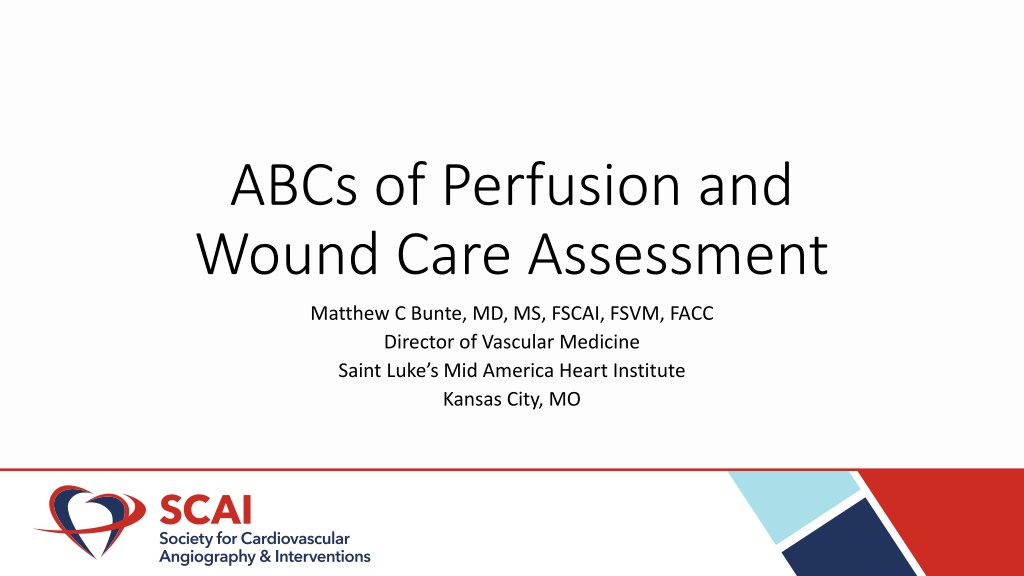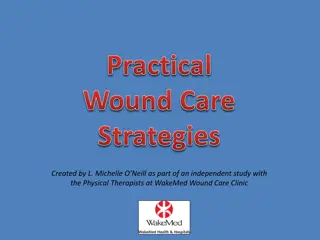Understanding Perfusion and Wound Care Assessment
This comprehensive presentation delves into the critical aspects of perfusion and wound care assessment, covering topics such as tissue oxygenation, measuring tissue perfusion, diagnostic testing for critical limb ischemia, and techniques like ankle and toe systolic pressure measurement and transcutaneous oximetry. Dr. Matthew C. Bunte provides valuable insights and strategies for evaluating and addressing infection, wound care, and conduits for optimal patient outcomes.
Download Presentation

Please find below an Image/Link to download the presentation.
The content on the website is provided AS IS for your information and personal use only. It may not be sold, licensed, or shared on other websites without obtaining consent from the author. Download presentation by click this link. If you encounter any issues during the download, it is possible that the publisher has removed the file from their server.
E N D
Presentation Transcript
ABCs of Perfusion and Wound Care Assessment Matthew C Bunte, MD, MS, FSCAI, FSVM, FACC Director of Vascular Medicine Saint Luke s Mid America Heart Institute Kansas City, MO
Disclosures None
Assess & address Infection Boots & bandages Wound Care Conduits Perfusion
Tissue oxygenation Collagen deposits O2 tension Oxygen tension < 20 mmHg inhibits fibroblast function, collagen synthesis Oxidative immune function depends on adequate O2 tension (>40 mmHg)
Tissue oxygenation O2 Supply O2 Demand O2 delivery O2 diffusion O2 consumption
Tissue Perfusion TSP/TBI Direct measurement of tissue oxygenation is difficult Measures of regional (e.g., ABI, TBI) and local (e.g., TcPO2, SPP) perfusion are surrogates Biomarkers (e.g., indocyanine green, phosphorescence) offer simultaneous assessment of regional and local perfusion TcPO2 & SPP Biomarkers ASP/ABI
2016 AHA/ACC Diagnostic Testing for CLI Gerhard-Herman MD, et al. Circulation. 2017;135(12):e726-e779
Ankle and Toe Systolic Pressure Measurement Medial arterial calcification falsely elevates BP, esp at ankle ABI false negatives are common in CLI In.PACT Deep: Only 6% had severely reduced ABI 29% w CLI and abnormal TSP had normal ABI TBI is standard for assessing pedal perfusion, although limitations persist Shishehbor MH, JVS, 2016:63(5):1311-7
Transcutaneous oximetry (TcPO2/TCOM) Measures fraction of oxygenated hemoglobin below skin surface Uses near-infrared spectroscopy with probes heated to 43 C Unaffected by medial arterial calcification with close correlation with TSP (goal > 40 mmHg) Useful when TSP unavailable (i.e., transmetatarsal amputation) Poor reproducibility, esp at low perfusion pressure, tissue edema
Skin perfusion pressure Assesses microperfusion 1-2 mm below epidermis Measured using radionuclide washout, photoplethysmography, laser Doppler Unaffected by medial arterial calcification Useful when TSP unavailable (i.e., transmetatarsal amputation) SPP 40 mmHg predicts wound healing, amputation level Holstein PE. 1985. Acta Ortho Scan. 213:1-47
Disclaimer Point measurements of tissue O2 tension may not accurately reflect the uniform magnitude wound hypoxia
Quantitative perfusion imaging Modality Technique Utility Limitations Computed tomography CT perfusion imaging Spatial flow maps Radiation, iodinated contrast, dual-energy CT Magnetic resonance imaging Arterial spin labeling (ASL); blood oxygen level-dependent (BOLD) imaging Tissue perfusion, transit time w non- contrast imaging Both ASL, BOLD require threshold blood flow; time sensitive; high signal-to-noise; local expertise Ultrasound Contrast-enhanced US Time-intensity map of blood flow Time intensive; local expertise; limited study in CLI Misra S, et al. Circulation. 2019. 140(12) e657-e672,
Indocyanin green fluorescence (ICG) imaging Constructs spatial maps for tissue perfusion Uses near-infrared spectroscopy to assess intensity of light emission from ICG marker Contains iodine Misra S, et al. Circulation. 2019. 140(12) e657-e672,
Hyperspectral imaging Constructs spatial maps for tissue oxygenation Uses spectroscopy to assess absorption profile of oxyhemoglobin Wavelengths penetrate 1- 4 mm below skin Misra S, et al. Circulation. 2019. 140(12) e657-e672,
Laser Doppler Flowmetry Measure of real-time tissue perfusion Laser light exploits interaction between coherent light and flowing hemoglobin Perfusion may be measured using laser Doppler or laser speckle imaging (LSI) LSI has advantages of high spatial resolution, deeper tissue penetration
Post-revascularization indicators of reduced amputation risk Wound blush1 Improvement in TSP2 Absolute increase in SPP (> 20 mmHg)3 Intraprocedural indicators of perfusion (e.g., laser speckle imaging, vascular flow reserve) under investigation 1. 2. 3. Utsunomiya M, et al. JACC CI. 2017;10(2): 188-194. Hammad TA, et al. CCI. 2017;90(6):986-993. Yamamoto K, et al. Vasc Med. 2018;23(3):243-249
Peripheral vascular flow reserve (VFR) Assesses microcirculatory function post intervention using thermodilution technique Post-proc VFR correlated with wound healing at 3-mo, 1-year Fukunaga M, et al. JACC CI. 2020;13(8):976-985
Conclusions Wound healing is a function of macrovascular and microvascular flow, among other factors Limitations of non-invasive wound perfusion testing important to understand Novel wound perfusion technologies require study but hold promise























